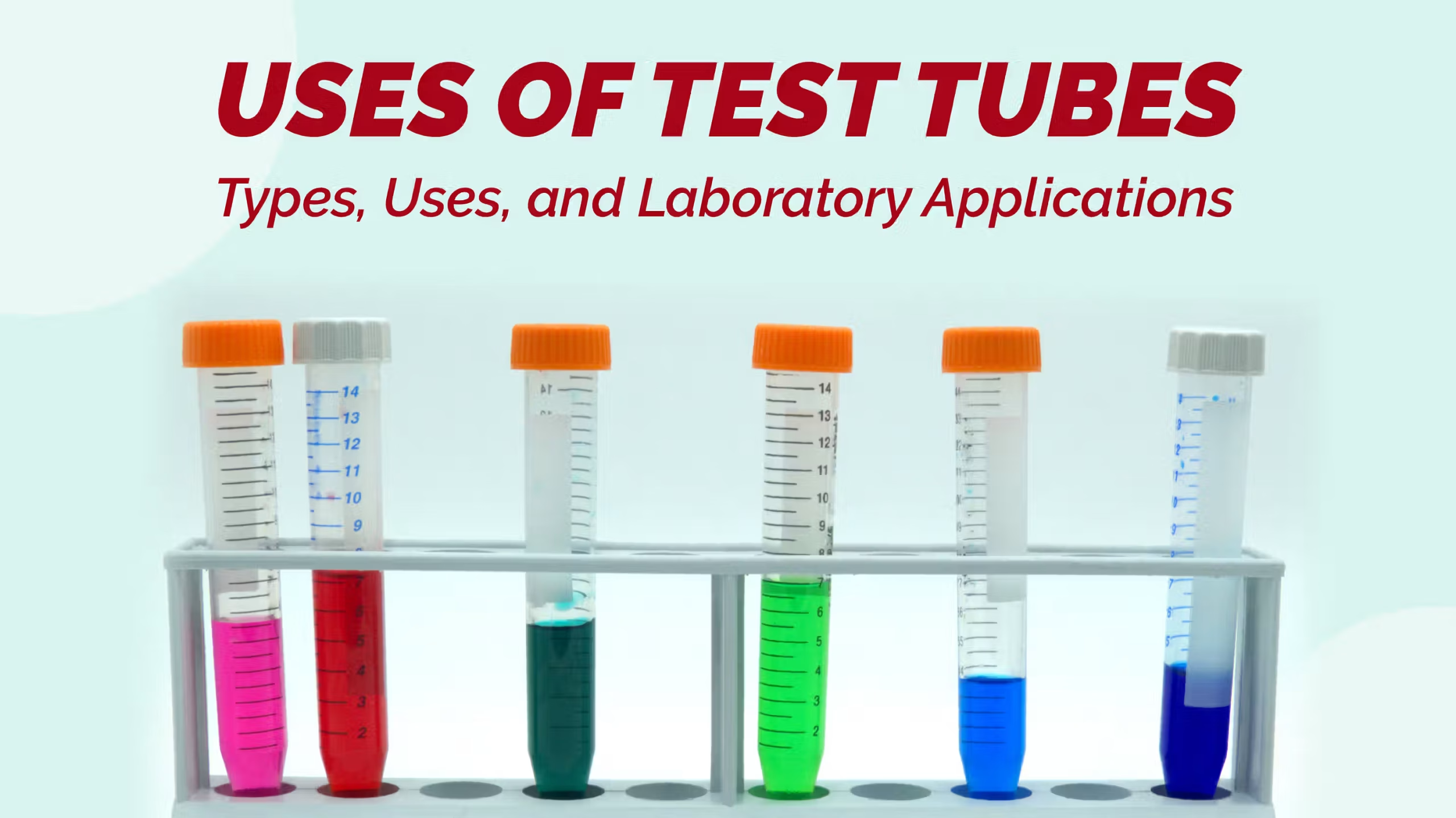Test Tubes: Types, Uses, and Laboratory Applications

A vital tool in any laboratory, the test tube is a slender glass container used for holding and manipulating samples during experiments. These tubes, also known as testing tubes due to their heat resistance, feature a U-shaped bottom and an open top for easy pouring and cleaning. While the exact inventor remains unknown, test tubes have been a mainstay in scientific research since the early 19th century.
Types of Test Tube:
Laboratory glassware is classified based on two criteria: the material used for construction and the purpose. Test tubes come in two types:
Disposable test tubes: Made of various plastics like nylon, polyethylene, polypropylene, and others. They are resistant to UV light, high temperatures, and chemicals.
Reusable test tubes: Constructed from glass, such as borosilicate or quartz glass. They are autoclavable, highly temperature-resistant, and durable, but more expensive than disposable ones. Other materials like metal and ceramic are less common for test tube construction.
Centrifuge Tube: A centrifuge tube is a cylindrical container used to hold samples during centrifugation. Made from materials like plastic or glass, these tubes are designed to withstand high-speed rotations. They come in various sizes and feature conical or round bottoms to facilitate the separation of different components in the sample based on density.
Types of Test Tube Based on Purpose:
The following is the classification for the test tube types available in the market.
- Thin-walled test tube: Used for storage, holding, and mixing, but not for heating due to the risk of breakage. Wall thickness is typically 0.5-0.6 mm.
- Thick-walled test tube: Designed for strong heating of chemicals due to its thick glass wall (1.5 mm).
- Rimmed test tube: Features a rim for extra mechanical strength and easy handling with a test tube holder.
- Screw top test tube: Secures materials inside the tube, commonly used for sample collection, culture media preparation, and blood collection.
- Plain top test tube: Without a rim or screw, ideal for holding chemicals before and during experiments.
- Medium-walled test tube: With a wall thickness of 1-1.2 mm, suitable for exothermic chemical reactions and gentle heating.
- Test tube with ground glass stopper: Used for chemical storage, featuring a ground glass top for stopper attachment.
- Graduated test tube: Functions like a graduated cylinder, accurately measuring samples before experiments, typically with a thick wall and interchangeable glass stopper.
Glass Test Tubes:
- Made from thin yet moderately strong glass, heat-resistant.
- Used for heating small amounts of matter in chemistry laboratories.
- Typically feature rounded bottoms.
- Known as culture tubes or sample tubes based on usage.
Clear Plastic Culture Tubes:
- Used in microbiology labs to hold microorganisms like bacteria and fungi.
- Positioned horizontally to maximize surface area for breeding.
Sterile Clear Plastic Sample Tubes (Vacutainers):
- Used in pathology and medical labs to collect and preserve body fluids, mainly blood and urine.
- Evacuated of air and sealed with caps to prevent organism growth.
- May contain additives, such as Sodium Citrate, to maintain blood liquidity.
- Color-marked for easy identification and to prevent errors during sample collection.
Laboratory Application of Test Tubes
- Sample Storage: Used for storing and preserving samples of liquids, solids, or gases for future analysis or experimentation.
- Mixing and Reaction: Employed for mixing reagents, conducting chemical reactions, and observing reaction outcomes.
- Heating: Suitable for heating small volumes of liquids or solids over a Bunsen burner or other heating sources.
- Centrifugation: Utilized in centrifuges for separating substances of different densities, such as cells, proteins, or nucleic acids.
- Measurement: Graduated test tubes are used to measure precise volumes of liquids or samples during experiments.
- Culture and Microbiology: Culture tubes are utilized for growing and maintaining microorganisms, including bacteria, fungi, and algae, in laboratory settings.
- Blood Collection: Vacutainer tubes are employed for collecting blood samples for diagnostic testing, with various additives to prevent coagulation or facilitate specific analyses.
- Storage and Transportation: Test tubes serve as portable containers for transporting samples between different laboratory locations or for fieldwork purposes.
Test tubes play a crucial role in laboratory settings, particularly when handling hazardous chemicals, contagious samples, and microbial cultures. Firstly, they aid in the safe handling of hazardous chemicals such as acids and bases, minimizing the risk of accidents and ensuring the safety of laboratory personnel and the environment. Additionally, test tubes enable the safe execution of experiments, providing a controlled environment for heating and mixing various substances. Their small-mouthed design reduces the likelihood of spillage and ensures precise handling of materials. Moreover, test tubes are invaluable for the storage and preservation of samples, facilitating long-term storage and retrieval when needed for further analysis or experimentation. Overall, test tubes are indispensable tools in laboratories, contributing to the efficiency, safety, and accuracy of scientific research and experimentation.



